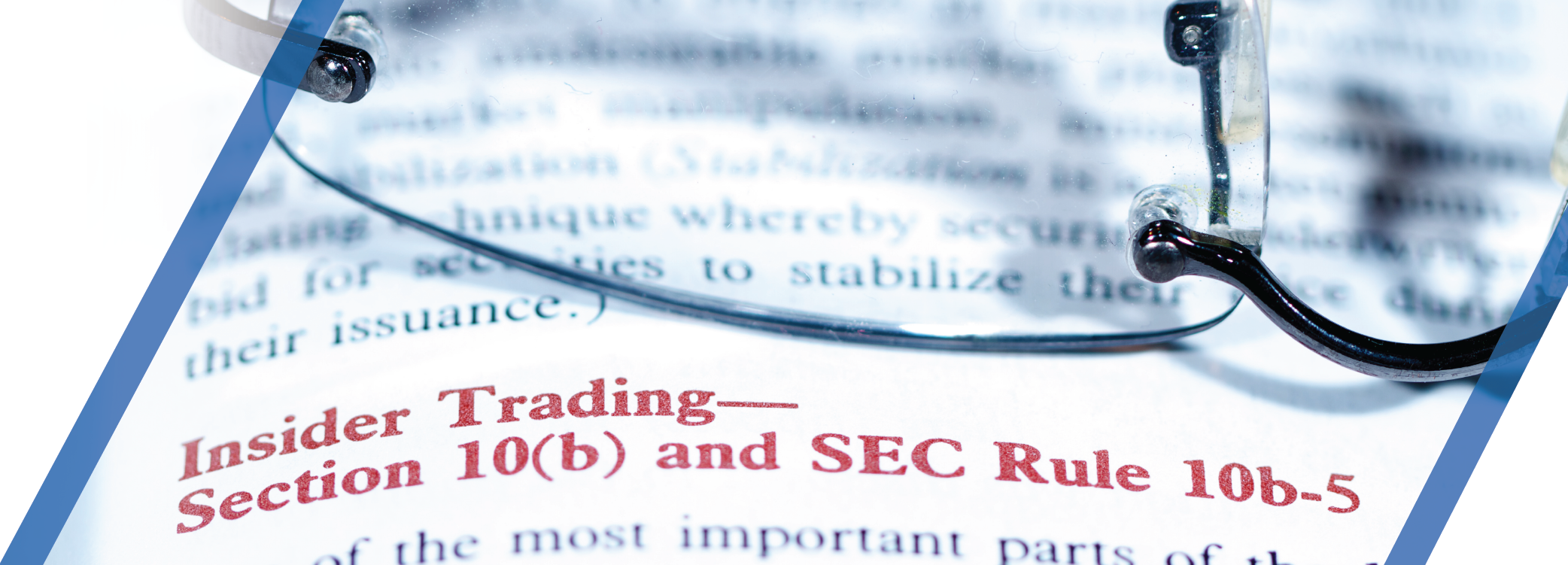The SEC Raises the Bar for Insiders and Issuers Regarding Rule 10b5-1 Plans
December 21, 2022 – Legal Alerts
The SEC, in a unanimous vote, adopted final rules on December 14, 2022 amending Rule 10b5-1 under the Securities Exchange Act of 1934. Additionally, it includes related amendments concerning disclosures about insider trading policies, disclosures about equity awards made close in time to the disclosure of material nonpublic information and the reporting of gifts by insiders. In adopting the rules, the SEC sought to address the perceived ability of insiders to trade opportunistically on the basis of material nonpublic information.
Effective Date
The final rules will become effective 60 days following publication of the adopting release in the Federal Register. Section 16 reporting persons will be required to comply with the amendments to Forms 4 and 5 for beneficial ownership reports filed on or after April 1, 2023. Issuers will be required to comply with the new disclosure requirements in Exchange Act periodic reports on Forms 10-Q, 10-K and 20-F and in any proxy or information statements in the first filing that covers the first full fiscal period beginning on or after April 1, 2023. Smaller reporting companies (public float of less than $250 million or, if less than $100 million in annual revenues, public float of less than $700 million) have an additional six months to comply with the new reporting requirements.
What Should You Do Now?
- Review current 10b5-1 plans to see whether they comply with the amended rules should they be amended or modified after the effective date.
- Consider and adjust the timing of when option grants are issued to avoid the new Reg. S-K Item 402(x) disclosures.
Overview of Final Rules
Rule 10b5-1(c) established an affirmative defense whereby insiders can set up future trades pursuant to a binding contract or plan adopted in good faith while the insider does not have material nonpublic information. The changes to Rule 10b5-1 update the conditions that must be met for the affirmative defense to apply to trading under such a plan. Specifically, the following new conditions must be met:
- All director and executive officer plans must have a “cooling-off period” before any trades can be made under a Rule 10b5-1 plan. The cooling-off period begins on the date of plan adoption or modification and must last until the later of: (1) 90 days thereafter; or (2) two business days following the disclosure in certain periodic reports of the issuer’s financial results for the fiscal quarter in which the plan was adopted or modified, but in no event later than 120 days. For those who are not directors or officers, a shorter cooling-off period of 30 days will be required, and issuers will not be subject to a cooling off-period at all.
- Directors and officers must include a representation in their Rule 10b5-1 plan certifying, at the time of the adoption of a new or modified plan, that: (1) they are not aware of material nonpublic information about the issuer or its securities; and (2) they are adopting the plan in good faith and not as part of a plan or scheme to evade the prohibitions of Rule 10b-5.
- Except for issuer Rule 10b5-1 plans, the affirmative defense will no longer apply to multiple, overlapping plans, and the use of single-trade plans (i.e., a plan covering a single trading event) is limited to one time during any consecutive 12-month period.
Additionally, the final rules adopt new disclosure requirements in Item 402(x) of Regulation S-K concerning the use of Rule 10b5-1 plans by issuers or insiders. The amendments will require issuers to provide:
- Quarterly disclosure regarding the use of Rule 10b5-1 plans and certain other written trading arrangements by an issuer’s directors and officers regarding the trading of its securities.
- Annual disclosure of an issuer’s insider trading policies and procedures and annual filing of such policies as exhibits.
- Certain tabular and narrative disclosures about issuer policies and practices and board of director considerations regarding the award of options close in time to (4 business days before until one business day after) the release of material nonpublic information.
- XBRL tagging of the required disclosures.
- For Form 4 and 5 filers, issuers will have to confirm whether reported transactions meet the affirmative defense conditions of Rule 10b-1(c) or not by checking certain boxes on the forms.
Further, officers and directors will no longer be permitted to report gifts of securities annually on Form 5. The amendments will require gifts of issuer securities by insiders to be reported within two business days on Form 4.
Overall, the amendments require more comprehensive disclosure about issuers’ policies and procedures relating to trading arrangements by its directors and officers. In light of these changes, issuers should review and revise, if needed, their insider trading policies and equity grant policies to ensure they facilitate compliance with the new 10b5-1 plan Rules. Companies may want to consider creating a standalone policy for Rule 10b5-1 plans that sets forth procedures and requirements for the adoption of 10b5-1 plans by company employees and directors.
If you still have questions about the newly adopted Rule 10b5-1 amendments, please reach out to David Lavan, Marisa Bens or your Dinsmore compliance representative.

